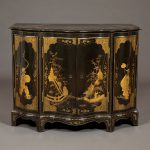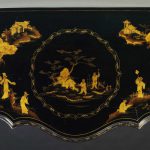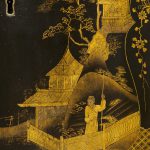8031 AN IMPOSING SERPENTINE FRONTED CHINOISERIE BLACK LACQUER SIDE CABINET Possibly Low Countries. Mid-Eighteenth Century. Measurements: Height: 36″ (91.5 cm) Width: 46 3/4″ (119 cm) Depth: 26 1/4″ (67 cm)

Research
Of black lacquer. The serpentine fronted top with molded edge with stylized foliate decoration centered by an oriental scene inside a decorative border flanked by oriental figures, the top above two conforming doors to the front with chinoiserie decoration within a restored diaper pattern border flanked by serpentine-fronted single doors each depicting an oriental figure within a diaper pattern border, the central doors opening to reveal an interior fitted with serpentine fronted shelves each with a molded edge, the side doors opening to reveal four serpentine fronted drawers, each drawer decorated with oriental scenes, with replaced brass drop handles. The sides with restored scenic landscape decoration. The whole above a molded edge with stylized decoration above six bracket feet joined by a continuous serpentine apron with stylized foliate decoration.
Provenance:
A Connecticut Collection
This unusual Chinoiserie cabinet was possibly made in the Low Countries, perhaps close to the famed center for decorated finishes in the town of Spa in Belgium.
Various technical aspects of the cabinet’s construction point to a Low Countries origin such as the wide gauge of the drawer linings in oak and wide single panel back. English influences are also present in the bracket feet and serpentine shaping. The Low Countries proximity and trade with Britain made Anglophile aspects of furniture design inevitable.
The lacquering is of an interesting character and again one detects the influence of English work particularly in the large figures of the flanking doors which are reminiscent of the oeuvre of the lacquerist workshop of Giles Grendey (1693-1780).
The cabinet’s internal configuration appears to have been made with a specific function in mind; the central section has exceptional slim shelves with narrow racking indicating possible storage of sheet music or maps. The outer flanks are fitted out with banks of four drawers that have been carefully lacquered to the quality of the exterior causing the supposition that the cabinet was an item in regular use with frequent access to its interior.
There exists a shaped mid-eighteenth century Dutch commode formerly in the collection of Daisy Fellowes, Donnington Grove whose interesting lacquer decoration was added in the early nineteenth century.1 Such activity as decorating preexisting pieces certainly occurred in England in the early nineteenth century and such a possibility cannot be ruled out in the case of this unusual piece.
Footnotes:
1. Carlton Hobbs, Catalogue Number Three, London, 1992, item 16.









Comments are closed.